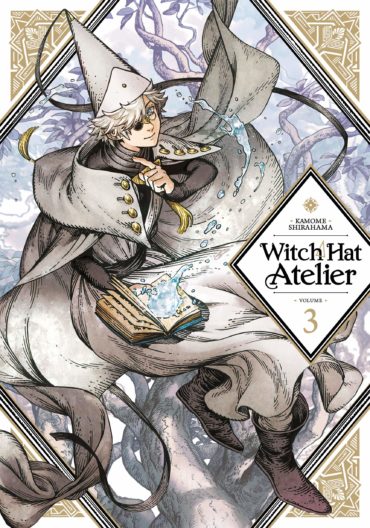Witch Hat Atelier Volume 3 Review
Coco and Agott have rescued a trapped boy from the flooded river – but the magic the girls employed has had a dramatic effect on the whole landscape, bringing the formidable Knights Moralis swooping down to investigate. Both girls are arrested and threatened with having their memories erased – but Tetia and Richeh intervene, followed by Master Qifrey who negotiates fiercely for their release. They are, after all, just children, he argues, and were only trying to help. However, does Qifrey have an ulterior motive? He has noticed that there’s something very different about Coco’s spell-writing ink – or maybe the ink bottle itself? He takes Coco back to the magic stationer’s shop in Kahln where they bought the writing materials and are let in by Tartah, Mister Nolnoa’s grandson. While the adults withdraw to talk, Tartah reveals his painful secret: he was born with silverwash syndrome, an eye condition that means he can’t distinguish different colours – a major handicap for anyone training to become a witch.
Qifrey has realized that Coco is being manipulated from afar by the forbidden order of the Brimmed Caps – after a dangerous experiment involving the ink bottle, rashly risking discovery by the order. What are their motives in using Coco? What are his motives in playing with fire? Is he just nobly trying to help his young apprentice? Or does he have another more sinister purpose in trying to track down the Brimmed Caps? The strain of the recent events takes its toll on poor Coco who collapses and has to be rushed to hospital.
The needs of children are very much centre-stage in this third and thrilling volume of Witch Hat Atelier – and the adults don’t always appear in a good light throughout these chapters. “There’s nothing I hate more…than adults who treat kids like things instead of people,” declares Richeh as she and Tetia rush to Coco and Agott’s defence, daring to defy the Knights Moralis. The growing friendship between Coco and Tartah dominates the second half of the book as Coco’s kindly nature begins to make the unhappy boy feel differently about his problems. “That’s what magic’s for,” she tells him encouragingly. “To turn things you can’t do…into things you can!”
Mangaka Kamome Shirahama introduces more tantalising hints of secret agendas and conspiracies hovering around Coco. The young protagonists are far from being pawns in the adults’ world and it’s very satisfying to watch Tartah, encouraged by Coco, discovering abilities he was unaware he possessed. And the art is wonderful as always. In some of the magical sequences, the images spill across the page, breaking free of the framing panels. There’s one image of Qifrey transporting Coco through a darkened grove of gnarled trees that reminds me of a Pauline Baynes Narnia illustration (a homage, maybe?) but the mangaka’s art is very much her own.
Stephen Kohler’s translation deals ably with all the new vocabulary the mangaka has created: there’s just the right feeling of ‘otherness’ to the names of the healing herbs Tartah reels off: “Thornbark…Mill-flower…Seabriar…Sleeping Willow and Drizzlebee Hive…”
One very small negative point: I’m not sure I like the rhyming blurbs on the reverse covers. They don’t quite work for me…although the final line ‘but ignorance is innocence’s curse’ is very pertinent to Coco’s dilemma. But it’s a minor complaint. This third enthralling instalment of Kamome Shirahama’s exquisitely drawn manga reveals just enough of the rapidly thickening plot to keep the reader impatient to read what happens next!


